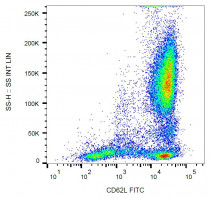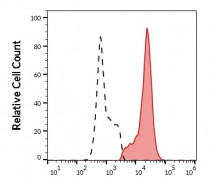ARG62906
anti-CD62L / L-Selectin antibody [LT-TD180] (FITC)
anti-CD62L / L-Selectin antibody [LT-TD180] (FITC) for Flow cytometry and Human
Cell Biology and Cellular Response antibody; Developmental Biology antibody; Immune System antibody; Signaling Transduction antibody
Overview
| Product Description | FITC-conjugated Mouse Monoclonal antibody [LT-TD180] recognizes CD62L / L-Selectin |
|---|---|
| Tested Reactivity | Hu |
| Tested Application | FACS |
| Specificity | The clone LT-TD180 reacts with CD62L (L-selectin), a 74-95 kDa single chain type I glycoprotein expressed on most peripheral blood B lymphocytes, T lymphocytes, monocytes and granulocytes; it is also present on a subset of NK cells and certain hematopoietic malignant cells. |
| Host | Mouse |
| Clonality | Monoclonal |
| Clone | LT-TD180 |
| Isotype | IgG1 |
| Target Name | CD62L / L-Selectin |
| Immunogen | Peripheral blood leukocytes |
| Conjugation | FITC |
| Alternate Names | Leukocyte surface antigen Leu-8; Leukocyte adhesion molecule 1; CD antigen CD62L; PLNHR; LSEL; CD62L; Leukocyte-endothelial cell adhesion molecule 1; L-selectin; LAM1; LNHR; TQ1; CD62 antigen-like family member L; gp90-MEL; Lymph node homing receptor; LYAM1; LECAM1; LEU8; LAM-1 |
Application Instructions
| Application Suggestion |
|
||||
|---|---|---|---|---|---|
| Application Note | * The dilutions indicate recommended starting dilutions and the optimal dilutions or concentrations should be determined by the scientist. |
Properties
| Form | Liquid |
|---|---|
| Purification Note | The purified antibody is conjugated with Fluorescein isothiocyanate (FITC) under optimum conditions. The reagent is free of unconjugated FITC and adjusted for direct use. No reconstitution is necessary. |
| Buffer | PBS, 15 mM Sodium azide and 0.2% (w/v) high-grade protease free BSA |
| Preservative | 15 mM Sodium azide |
| Stabilizer | 0.2% (w/v) high-grade protease free BSA |
| Storage Instruction | Aliquot and store in the dark at 2-8°C. Keep protected from prolonged exposure to light. Avoid repeated freeze/thaw cycles. Suggest spin the vial prior to opening. The antibody solution should be gently mixed before use. |
| Note | For laboratory research only, not for drug, diagnostic or other use. |
Bioinformation
| Database Links | |
|---|---|
| Gene Symbol | SELL |
| Gene Full Name | selectin L |
| Background | CD62L (L-selectin) is an adhesion glycoprotein that is constitutively expressed on the cell surface of leukocytes and mediates their homing to inflammatory sites and peripheral lymph nodes by enabling rolling along the venular wall. CD62L is also involved in activation-induced neutrophil aggregation. Activation-dependent CD62L shedding, however, counteracts neutrophil rolling. CD62L has also signaling roles including enhance of chemokine receptor expression. Similarly to CD62P, the major ligand of CD62L is PSGL-1 (P-selectin glycoprotein ligand-1). |
| Function | Cell surface adhesion protein. Mediates the adherence of lymphocytes to endothelial cells of high endothelial venules in peripheral lymph nodes. Promotes initial tethering and rolling of leukocytes in endothelia. [UniProt] |
| Research Area | Cell Biology and Cellular Response antibody; Developmental Biology antibody; Immune System antibody; Signaling Transduction antibody |
| Calculated MW | 42 kDa |
Images (2) Click the Picture to Zoom In
-
ARG62906 anti-CD62L / L-Selectin antibody [LT-TD180] (FITC) FACS image
Flow Cytometry: Human peripheral blood cells stained with ARG62906 anti-CD62L / L-Selectin antibody [LT-TD180] (FITC).
-
ARG62906 anti-CD62L / L-Selectin antibody [LT-TD180] (FITC) FACS image
Flow Cytometry: Separation of human CD62L positive lymphocytes (red-filled) from CD62L negative lymphocytes (black-dashed). Human peripheral whole blood stained with ARG62906 anti-CD62L / L-Selectin antibody [LT-TD180] (FITC) (20 µl reagent / 100 µl of peripheral whole blood).









